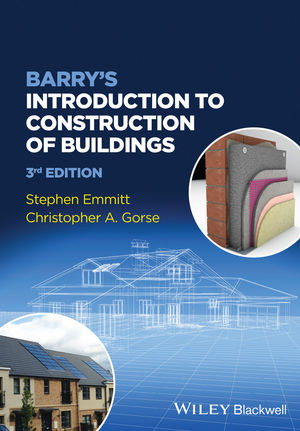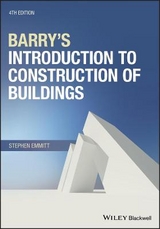
Barry′s Introduction to Construction of Buildings
John Wiley & Sons Inc (Verlag)
978-1-118-25542-1 (ISBN)
- Titel erscheint in neuer Auflage
- Artikel merken
Robin Barry's Construction of Buildings was first published in 1958 in 5 volumes, rapidly becoming a standard text on construction. In its current 2 volume format Barry remains hugely popular with both students and lecturers of construction and related disciplines. The third edition of Barry s Introduction to Construction of Buildings provides the basic material you will need to understand the construction process for the majority of low rise buildings. Construction technology is explained and illustrated through the key functional and performance requirements for the main elements common to all buildings. With a stronger focus on building efficiency and meeting the challenges posed by limiting the environmental impact of buildings, you will find the text fully up to date with the latest building regulations and construction technologies. Particular attention has been paid to the careful integration of all topics, helping you to link concepts and follow related material. The new edition, with supporting website at www.wiley.com/go/barrysintroduction, provides the ideal introduction to construction technology
Stephen Emmitt BA(Hons), Dip. Arch, MA (Prof. Ed.), PhD is Professor of Architectural Practice in the Department of Architecture and Civil Engineering at the University of Bath, and Visiting Professor in Innovation Sciences at Halmstad University, Sweden. He is a registered architect with industrial experience and teaches architectural technology and architectural detailing across a wide range of built environment programmes in the UK, Europe and Asia. Christopher A. Gorse BSc (Hons), MSc. PhD, MCIOB, MAPM, FLTM, Cert. Ed, Dip (Ed.), Dip (H&S) is Professor of Construction and Project Management, Director of the Leeds Sustainability Institute and Head of the Centre for the Built Environment at Leeds Metropolitan University. He leads projects in the areas of sustainability, low carbon and building performance and has an interest in domestic new build, commercial buildings and refurbishment.
Preface vii Acknowledgements ix About the Companion Website x 1 Introduction 1 1.1 The function and performance of buildings 1 1.2 Environmental factors 4 1.3 General principles of construction 6 1.4 Regulations and approvals 11 1.5 Making choices and sources of information 13 2 Site Analysis and Set-Up 15 2.1 Function of the site analysis 15 2.2 The desk-top study 16 2.3 Site reconnaissance 19 2.4 Soil investigations 23 2.5 The performance appraisal 34 2.6 Site set-up and security 34 3 Groundwork and Foundations 38 3.1 Functional requirements 38 3.2 Bedrock and soil types 39 3.3 Ground movement 41 3.4 Foundation construction 45 3.5 Site preparation and drainage 72 4 Floors 87 4.1 Functional requirements 87 4.2 Ground supported concrete slab 90 4.3 Suspended concrete fl oor slabs 97 4.4 Suspended timber ground fl oors 104 4.5 Resistance to the passage of heat 108 4.6 Reinforced concrete upper fl oors 109 4.7 Timber upper floors 117 5 Walls 128 5.1 Functional requirements 128 5.2 Damp-proof courses (dpcs) 134 5.3 Stone 142 5.4 Stone masonry walls 145 5.5 Bricks and brickwork 160 5.6 Bonding bricks 170 5.7 Blocks and blockwork 177 5.8 Mortar 181 5.9 Loadbearing brick and block walls 186 5.10 Solid wall construction 192 5.11 Cavity wall construction 218 5.12 Timber 246 5.13 Timber-framed walls 252 5.14 Steel frame wall construction 279 5.15 Internal and party walls 279 5.16 Straw wall construction 281 5.17 Earth wall construction 288 6 Roofs 295 6.1 Functional requirements 295 6.2 Pitched roofs 300 6.3 Pitched roof coverings 322 6.4 Sheet metal covering to low pitch roofs 342 6.5 Thermal insulation to pitched roofs 345 6.6 Flat roofs 351 6.7 Timber flat roof construction 353 6.8 Concrete flat roofs 371 6.9 Thermal insulation to flat roofs 374 6.10 Parapet walls 379 6.11 Green roofs 383 7 Windows 389 7.1 Functional requirements 389 7.2 Window types 416 7.3 Window frames 426 7.4 Glass and glazing 452 7.5 Hardware 471 7.6 Window cills 473 8 Doors 480 8.1 Functional requirements 480 8.2 Door types 485 8.3 Door frames and linings 508 8.4 Hardware 524 9 Stairs and Ramps 531 9.1 Functional requirements 533 9.2 Materials, terms and definitions 537 9.3 Types of stair 544 9.4 Timber staircases 547 9.5 Stone stairs 557 9.6 Reinforced concrete stairs 559 9.7 Structural glass stairs 563 9.8 Ramps 564 10 Surface Finishes 567 10.1 Functional requirements 567 10.2 Floor fi nishes 569 10.3 Wall and ceiling finishes 577 10.4 Skirtings and architraves 593 10.5 Painting and decorating 597 10.6 External rendering 603 11 Internal Environment and Energy Supply 608 11.1 Functional requirements 608 11.2 Indoor climate control 609 11.3 Energy sources 612 11.4 Solid fuel-burning appliances 621 11.5 Domestic gas installations 637 11.6 Domestic electrical supply and installations 642 11.7 Artificial lighting 662 11.8 Electronic communication systems: Broadband 664 12 Water Supply and Sanitation 671 12.1 Cold water supply and distribution 671 12.2 Hot water supply and distribution 681 12.3 Water services to multi-storey buildings 689 12.4 Pipes (tubulars) for water supply 698 12.5 Sanitary appliances 704 12.6 Foul drainage 724 12.7 Roof drainage 757 12.8 Surface water drainage and sustainable drainage systems (SuDS) 765 12.9 Refuse storage and recycling 769 13 Heat Loss and Calculations 771 13.1 Principles and performance requirements 771 13.2 Heat loss calculations 773 13.3 Testing and monitoring thermal performance 786 Appendix A: Websites 790 Appendix B: References 791 Index 793
| Erscheint lt. Verlag | 23.6.2014 |
|---|---|
| Verlagsort | New York |
| Sprache | englisch |
| Maße | 172 x 241 mm |
| Gewicht | 1500 g |
| Themenwelt | Technik ► Bauwesen |
| ISBN-10 | 1-118-25542-9 / 1118255429 |
| ISBN-13 | 978-1-118-25542-1 / 9781118255421 |
| Zustand | Neuware |
| Informationen gemäß Produktsicherheitsverordnung (GPSR) | |
| Haben Sie eine Frage zum Produkt? |
aus dem Bereich



